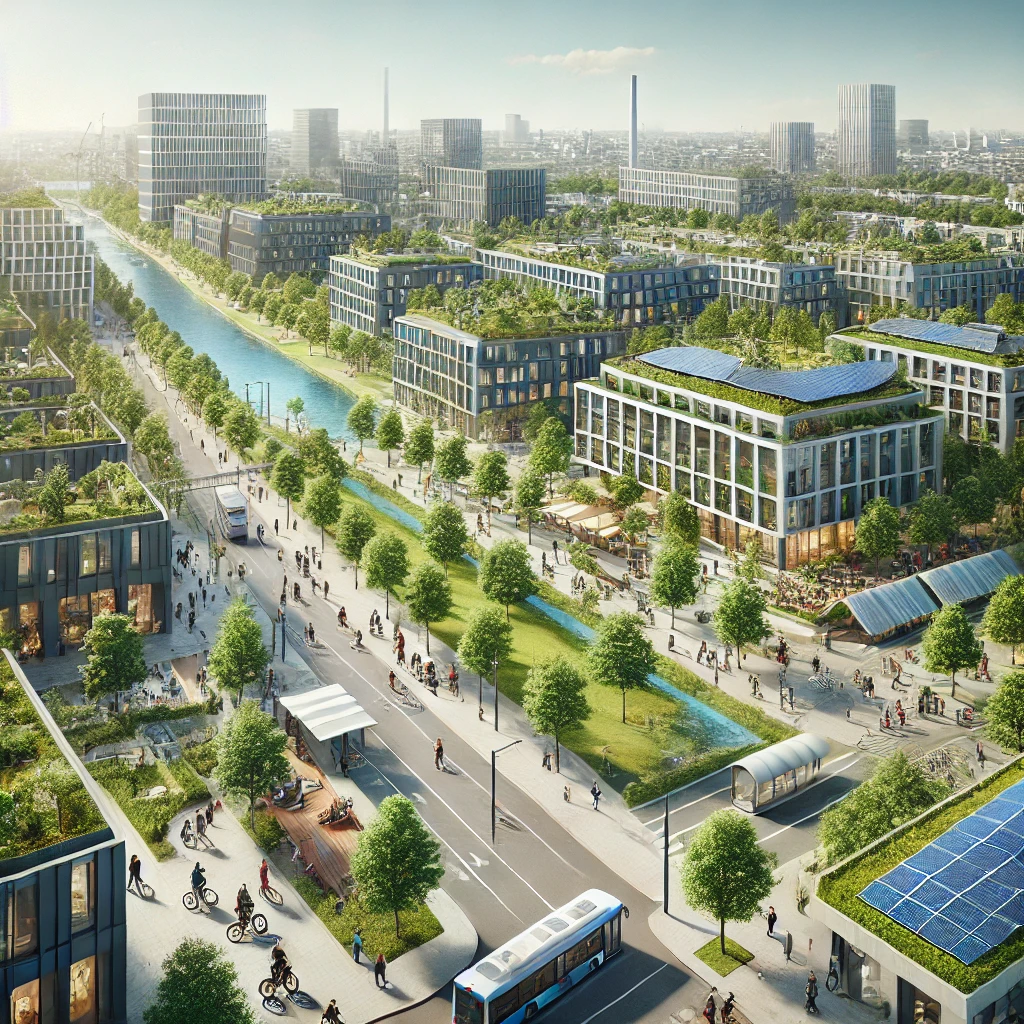
As the global population continues to urbanize, the challenge of designing cities that are both sustainable and livable has become a pressing concern. Urban planning and design play a crucial role in shaping cities to meet the needs of their residents while ensuring environmental, social, and economic sustainability. This article explores the role of urban planning in creating cities that foster a high quality of life and reduce their environmental impact.
1. Defining Sustainable and Livable Cities
1.1 Sustainability in Urban Development
A sustainable city is one that minimizes its environmental footprint, uses resources efficiently, and promotes ecological balance. This involves reducing carbon emissions, conserving water and energy, managing waste, and integrating green spaces into urban environments.
1.2 Livability as a Core Principle
Livable cities, on the other hand, focus on human well-being and quality of life. They prioritize access to essential services, affordable housing, efficient public transportation, safety, and a sense of community. Livability also involves promoting equity, inclusiveness, and opportunities for all residents.
1.3 The Intersection of Livability and Sustainability
Sustainability and livability are interconnected; a truly sustainable city must also be livable. A well-planned city that reduces environmental degradation while enhancing the quality of life for its citizens can serve as a model for future urban development.
2. Key Principles of Urban Planning for Sustainable and Livable Cities
2.1 Efficient Land Use and Zoning
Urban planning focuses on how land is used within a city, ensuring a balance between residential, commercial, industrial, and green spaces. Zoning strategies can reduce urban sprawl by promoting denser, mixed-use neighborhoods that allow residents to live, work, and play within the same area. This approach cuts down on commuting times, reduces pollution, and fosters community interaction.
2.2 Transportation and Mobility Planning
Sustainable urban design prioritizes public transportation, walking, and cycling over car dependency. Well-planned transportation systems reduce congestion, lower emissions, and make cities more accessible. The development of mass transit networks, bike lanes, and pedestrian-friendly streets encourages a shift toward more sustainable modes of mobility.
2.3 Green Infrastructure
Incorporating green spaces such as parks, gardens, and urban forests within cities is vital for environmental health and livability. Green infrastructure helps mitigate the urban heat island effect, absorbs rainwater, reduces air pollution, and provides recreational spaces that improve mental and physical well-being. It also supports biodiversity by creating habitats for plants and animals within urban areas.
2.4 Energy Efficiency and Renewable Resources
Urban design can promote energy efficiency through building codes, renewable energy integration, and smart city technologies. High-efficiency buildings that use sustainable materials, rooftop solar panels, and energy-efficient lighting systems contribute to reducing the overall carbon footprint of a city. Incorporating smart grids and sustainable energy solutions makes cities less reliant on nonrenewable resources.
2.5 Water Management
Efficient water management is critical for the sustainability of cities, especially in regions prone to water scarcity or flooding. Urban planning must include systems for rainwater harvesting, wastewater recycling, and sustainable drainage systems to manage water resources efficiently. Green roofs and permeable pavements are examples of design solutions that help cities handle stormwater while reducing environmental impacts.
2.6 Waste Management and Circular Economy
Sustainable cities prioritize reducing, reusing, and recycling waste. Urban planners must implement systems for solid waste management, composting, and recycling while promoting a circular economy, where materials are continuously reused, rather than discarded. Well-designed waste management infrastructure reduces landfill usage and minimizes the environmental impact of urban consumption.
3. Social and Economic Dimensions of Urban Planning
3.1 Affordable and Inclusive Housing
A livable city is one that provides affordable housing options for all socioeconomic groups. Urban planning plays a key role in creating inclusive housing policies, ensuring that lower-income families have access to safe and well-located housing. Mixed-income housing developments foster social integration and reduce economic segregation.
3.2 Public Spaces and Social Cohesion
Urban design influences the quality and availability of public spaces such as parks, plazas, and community centers. These spaces encourage social interaction, promote cultural exchange, and build a sense of community. Livable cities focus on making these areas accessible to all residents, regardless of their background or income level.
3.3 Economic Opportunities and Employment
Sustainable urban planning supports local economies by creating environments where businesses can thrive and residents can find employment opportunities close to where they live. Mixed-use developments, which combine residential, commercial, and industrial spaces, create dynamic neighborhoods that provide both jobs and services to residents.
3.4 Health and Well-Being
Designing cities that promote healthy lifestyles is essential for livability. Access to healthcare services, recreational facilities, clean air, and safe streets are key factors that contribute to physical and mental well-being. Cities that encourage walking, cycling, and outdoor activities through urban design have healthier and more active populations.
4. Mitigating Climate Change Through Urban Design
4.1 Reducing Carbon Emissions
Urban areas are significant contributors to global carbon emissions, mainly due to transportation, energy use, and industrial activities. Urban planners can reduce a city’s carbon footprint by designing compact, walkable neighborhoods, promoting energy-efficient buildings, and encouraging the use of clean energy sources. Developing low-emission zones within cities and enhancing green transportation options are also effective strategies.
4.2 Resilience to Climate Impacts
As climate change leads to more frequent and severe weather events, urban planning must incorporate resilience strategies. Designing flood-resistant infrastructure, increasing the use of permeable surfaces to manage stormwater, and creating heat-resistant urban environments are essential for cities to withstand the challenges posed by climate change. Incorporating adaptive design measures ensures that cities remain functional and livable even in the face of environmental uncertainties.
5. Innovative Technologies in Urban Planning
5.1 Smart Cities and Data-Driven Planning
The rise of smart city technologies allows urban planners to use data and technology to optimize the efficiency and sustainability of city systems. Real-time data on traffic, energy consumption, air quality, and public services can help planners make informed decisions that improve the overall livability and environmental impact of cities. Technologies like IoT (Internet of Things), AI, and big data analytics play a significant role in this transformation.
5.2 Sustainable Architecture and Building Design
Urban planning increasingly incorporates innovative architectural practices that focus on sustainability. Passive solar design, green roofs, energy-efficient buildings, and modular construction are becoming central components of sustainable urban design. These innovations help reduce resource consumption and create healthier living environments.
6. Public Participation and Community Involvement
6.1 Engaging Citizens in Planning Processes
A key factor in creating sustainable and livable cities is ensuring that the needs and perspectives of residents are considered in urban planning. Public participation in decision-making processes allows communities to voice their concerns and contribute to the development of urban spaces that reflect their priorities. This inclusiveness fosters a sense of ownership and engagement, leading to stronger communities and better urban outcomes.
6.2 Collaborative Governance and Policy Integration
Sustainable urban planning requires coordination between government agencies, private stakeholders, and the public. Collaboration ensures that policies related to transportation, housing, environmental protection, and economic development work together cohesively. Policymakers, urban planners, and residents must share a common vision to achieve the long-term sustainability and livability of a city.
Urban planning and design are vital to shaping the future of cities, ensuring they are both sustainable and livable. Through efficient land use, green infrastructure, sustainable energy systems, and inclusive social policies, urban planners can create cities that meet the needs of their residents while minimizing environmental impact. As cities continue to grow, the integration of innovative technologies, climate resilience measures, and public participation will be essential in creating urban spaces that enhance both human and environmental well-being. Sustainable, livable cities are not only the foundation for a better quality of life but also the key to addressing the global challenges of the future.

